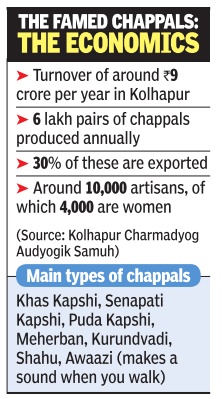Kolhapuri chappals
This is a collection of articles archived for the excellence of their content. |
Contents |
Decline of a craft
2016
The Times of India Feb 01 2016
Priyanka Kakodkar
Ban On Bullock Slaughter Adds To Crisis
Shaded from the sharp afternoon sun, rows upon rows of hutments in the city's Subhashnagar colony are thrumming with activity .Bent over stone slabs, the men cut, scrape and hammer sheets of leather while their wives do the braiding, stitching and punching.
They are fashioning one of Maharashtra's most iconic brands: its hand-crafted Kolhapuri slippers.Subhashnagar is the largest enclave of chappal-makers in the entire district. Yet, the families are locked in a race against time.
“We are the last generation of chappal-makers. Our children don't want to do this,“ says 60-year-old Prakash Lokare, who started out at the age of seven. His son works at a shop which makes seat covers for cars. Many have shifted to construction work.
The home-based cottage industry , worth around Rs 9 crore according to local manufacturers, has been on the decline for years, thanks to the flood of brightly-coloured knock-offs from the north and Karnataka, and the clo sure of local tanneries for violating green norms.
The extension of the cow slaughter ban in the state to include bullocks since last year has added to the crisis.
The chappals were once made from both buffalo and bullock hide. The rougher buffalo hide formed the bottom of the sole, while the softer bullock leather was used for the top layer touching the feet. In some cases, entire slippers were crafted from either bullock or buffalo hide. The bulk of the leather used for the slippers comes from tanneries in Chennai, a dependence compounded by the closure of local tanneries. Still, until last year, hides sourced from Kolhapur formed at least 15% of the market, manufacturers say.
After the beef ban, the reduction in supply pushed up prices. “We have had a 50% drop in business. With no bullock hides in the market, the price of buffalo leather has shot up from Rs 110 a kg last year to almost Rs 280 this year,“ says Arun Satpute, among the major manufacturers in the area.
“We used to make between 3,0004,000 pairs of slippers each month last year. Now it is down to 2,000,“ adds Satpute. The profit margins of his workshop have shrunk from 35% to just 1015%. Besides running his own outfit, Satpute is also chairman of the industry's umbrella body , the Kolhapur Charmadyog Audyogik Samuh.
Maruti Shamrao Gawli, who runs the retail store Kala footwear, is particularly disappointed. He had sent Kolhapuri slippers for PM Narendra Modi when he addressed a rally here during the Lok Sabha election campaign in 2014. “Mr Modi had said the country needs Kolhapuri chappals to progress faster but now their own BJP government in Maharashtra enforced the beef ban,“ he says bitterly .
The chappal artisans -who hail from the Scheduled Caste Chambar community -feel the pinch the most. The Audyogik Samuh estimates there are less than 10,000 artisans left in the district.
Inspiring Prada
2025
June 28, 2025: The Times of India
So, here’s what went down: Prada recently showcased its Spring-Summer 2026 men’s collection, and one particular piece had Indian fashion watchers doing a double take, sandals that looked way too familiar. Yep, they strongly resembled Kolhapuri chappals, the iconic handmade leather footwear from Maharashtra. But instead of owning up to the source of inspiration, Prada casually referred to them as just “leather sandals” in their show notes. Naturally, this didn’t sit well with a lot of people.
Lalit Gandhi, the president of the Maharashtra Chamber of Commerce, Industry and Agriculture, was among the first to call the brand out. He reminded them and the world that Kolhapuris aren’t just any old sandals. They carry cultural and artisanal weight and even have a GI (Geographical Indication) tag since 2019.Fast forward a few days and Prada seems to have gotten the message.
Lorenzo Bertelli, who heads CSR at the Prada Group, sent a letter to Gandhi acknowledging the “inspiration” behind the sandals. He admitted that the design was indeed influenced by traditional Indian handcrafted footwear, which has, as he put it, “a centuries-old heritage.” (Took them long enough, right?)Bertelli also clarified that the collection is still in its early design phase and hasn’t gone into production or sale, yet. He added that Prada respects Indian craftsmanship and wants to explore ways to work more closely with local artisans in the future.While it’s good that Prada finally acknowledged the roots of the design, Gandhi’s larger point still stands: cultural exchange in fashion is great, but it has to come with proper credit and collaboration. It's not enough to just "borrow" it’s about recognizing where things come from and supporting the people who’ve kept those traditions alive.If this leads to big brands actually uplifting traditional crafts instead of just repackaging them, it might be a step in the right direction for the fashion industry.
